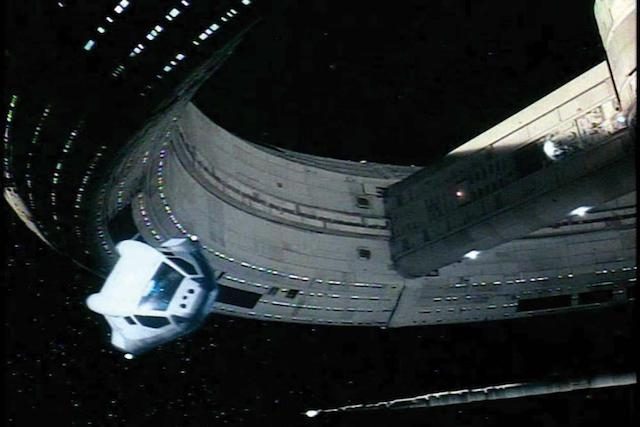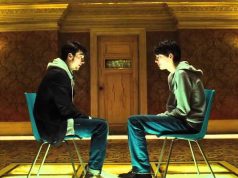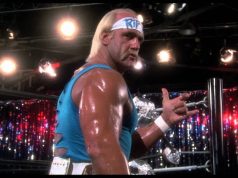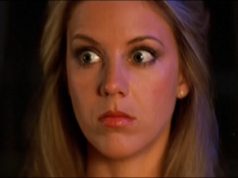
“Solar Crisis” bravely assigns itself a plot with the highest possible stakes — the destruction of every living thing on Earth! — and addresses it by having a lot of men stand around a spaceship bridge and talk. While I grant you that this is probably a realistic portrayal of how the world’s governments would actually respond to such a crisis, it does not make for a thrilling movie.
It makes for a pretty bad movie, in fact — so bad that it’s credited to “Alan Smithee,” which means the real director didn’t want his name on it. How bad does a movie have to be for the man who made it to disavow his association with it? I mean, “Solar Crisis” isn’t much worse than “Transformers: Revenge of the Fallen,” and Michael Bay proudly put his name on that. Although maybe “Michael Bay” is actually a pseudonym for Alan Smithee. Maybe when a movie is so bad even the fictional Alan Smithee wants nothing to do with it, it’s credited to Michael Bay. I bet that’s it. Prove me wrong.
Set in the year 2050 or thereabouts, “Solar Crisis” has all of planet Earth worried about the stupid Sun and its stupid solar flares. The scientists, who wear lab coats and bow ties so we know they’re scientists, report that soon there’s going to be a “mega flare” so large it could reach Earth’s orbit and cook us all. “The cremation of the planet is at hand!” is what the narrator says, again filling the viewer with false hopes of being excited. Mankind’s only chance is to drop a giant anti-matter bomb directly into the flare, thereby diverting it and making it burn up some other planet instead.
A ship called the Helios is on its way to complete this mission, staffed by a crew of men and women who are all really intense yet somehow also really boring. They UTTER! every LINE! with such CONVICTION!, but they never say anything interesting. It’s like if you crossed a Pentecostal preacher with a calculus professor. They have fervent but dull discussions about how to accomplish the mission, peppered with sci-fi jargon like “electromagnetic shields” and “radiation modulators” and “science.”
Back on Earth, a ruthless corporate billionaire named Teague (Peter Boyle) intends to stop the Helios from completing its mission. He wants to profit from people’s panic over the impending mega-flare, I guess by selling them air-conditioners or sunscreen or whatever, and if the Helios does its job, the panic will end and Teague’s profits will dry up. Of course, if the Helios fails, the mega-flare will bake the Earth, and Teague’s profits will dry up because they will be on fire, as will Teague himself. Never you mind, though. Teague has concluded that the mega-flare isn’t going to happen anyway. Sure, all the scientists say otherwise. But since when do scientists know more about science than corporate billionaires?? (That’s actually Exxon Mobil’s company motto.)
Back on the Helios, one of the crew members is a lady named Alex (Annabel Schofield) who’s actually a “biogenetically engineered human,” which is sort of like being a cyborg except it doesn’t require any special effects or makeup. Teague has one of his stooges reprogram Alex to sabotage the mission, after Alex takes a naked, sexy shower. But if Teague has a stooge on the Helios anyway, why doesn’t the stooge do the sabotaging himself? Most likely the stooge is trained for reprogramming biogenetically engineered humans but not for sabotaging, as those are two totally different specializations in the stooge field.
So things start malfunctioning on the ship, and mini-missions are required to repair them. All the characters seem to know what these crises are about, but darned if they explain them to us. “The cryogenic fuselage is warped!” “You’ll have to de-crank it manually!” “Be careful not to inveigle the denominator!” “Aaah! It’s killing me!” Then everybody is sad that this nameless crew member has died doing whatever this vague but clearly important task was, and then the next thing goes wrong and we repeat the cycle, a hundred times.
I think you’ll agree that what I’ve told you so far is PLENTY of story for one movie. The Sun wants to kill us; we have to stop it by throwing a bomb at it; somebody wants to thwart the plan; the end. Danny Boyle later made a film called “Sunshine” that used the same basic scenario, though he did add the important detail of not being terrible. But “Solar Crisis” is not content to bore us for 80 minutes with a turgid sci-fi adventure. “Solar Crisis” wants to bore us for 110 minutes with a turgid sci-fi adventure that also has a turgid sci-fi subplot!
The subplot is that the commander of the Helios, Steve Kelso (Tim Matheson), is at odds with his father, who is a space admiral played by Charlton Heston. Yes, that is Charlton Heston as Adm. “Skeet” Kelso, the part he was born to play. The source of Steve and Skeet’s friction is Steve’s teenage son, Mike (Corin Nemec), who’s gone AWOL from military academy. Back on Earth, we find Mike in the desert, where he meets a crazy desert lunatic played by Jack Palance who helps him get to a spaceport so he can go up to space and join his father and grandfather on the mission, because that’s fun and school is lame. Meanwhile, Grandpa Skeet is leaving space to come to Earth to look for his grandson! These two basically cancel each other out, in other words, and you could eliminate the whole dumb subplot without losing anything. Of course, then you’d lose Charlton Heston and Jack Palance, and I guess those are two actors you want to use however you can, whether it makes sense or not.
— Film.com





